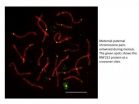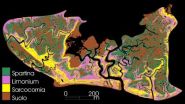(Press-News.org) Neil Hunter's laboratory in the UC Davis College of Biological Sciences has placed another piece in the puzzle of how sexual reproduction shuffles genes while making sure sperm and eggs get the right number of chromosomes.
The basis of sexual reproduction is that a fertilized egg gets half its chromosomes from each parent — sperm and eggs each contributing one partner in each pair of chromosomes. We humans have 23 pairs of 46 chromosomes: so our sperm or eggs have 23 chromosomes each.
Before we get to the sex part, though, those sperm and eggs have to be formed from regular body cells that contain twice as many chromosomes. That happens through a specialized type of cell division, meiosis.
During meiosis, the couples in each pair of chromosomes have to, well, couple by "crossing over" with each other. Each chromosome pair must become connected by at least one crossover so that when the couples separate, they are delivered to separate sperm or egg cells.
These crossovers also mean that chromosomes can exchange chunks of DNA with each other, shuffling the genetic deck for the next generation. But if too few crossovers are formed, gametes end up with the wrong number for chromosomes, a situation that can cause infertility, pregnancy miscarriage or chromosomal diseases such as Down Syndrome.
Large-scale studies of human genetics have shown that the number of crossovers formed during meiosis is under genetic control. Moreover, women that make more crossovers tend to have more children. One gene suggested to control crossover numbers in humans, called Rnf212, is the subject of a new study by UC Davis researchers lead by Professor Neil Hunter.
Hunter studies how crossovers form and chromosomes separate at the UC Davis Department of Microbiology & Molecular Genetics and the Comprehensive Cancer Center. In 2009, he was awarded an early career fellowship from the Howard Hughes Medical Institute.
Chromosome pairs entwined during meiosis. Green spots show the location of RNF212. (Neil Hunter/UC Davis)The latest paper from Hunter's lab, published Feb. 10 in Nature Genetics, shows that Rnf212 is essential for crossing-over in mammalian cells. Crossovers form by a process called homologous recombination, in which chromosomes are first broken and then repaired by coupling with a matching template chromosome. Although hundreds of recombination events are started in each cell, only one or two crossovers will form between any given pair of chromosomes.
"There isn't a special, predetermined site for a crossover. It can occur just about anywhere along a chromosome. But there has to be at least one and there always is," Hunter said.
In a series of experiments in mouse cells, graduate student April Reynolds, Hunter and colleagues found that the RNF212 protein defines where crossovers will occur by binding to just one or two recombination sites per chromosome where it triggers the accumulation of the protein machinery that actually carries out the cutting and splicing of DNA.
Mice that lacked the gene for RNF212 were sterile. Mice that had one working copy of the gene were fertile, but on careful examination there were fewer crossovers formed while sperm and eggs were being made than in normal mice, potentially reducing fertility. It's possible that this might be tied to some causes of infertility in humans.
It remains unclear how each pair of chromosomes always manages to crossover at least once. But Hunter says he is, "convinced that RNF212 holds the key to understanding this unique problem in chromosome biology."
INFORMATION:
The full author list of the paper is: April Reynolds, Huanyu Qiao, Ye Yang, Jefferson Chen, Neil Jackson, and Kajal Biswas, all in Hunter's laboratory at UC Davis; J Kim Holloway, Cornell University; Frédéric Baudat and Bernard de Massy, Centre National de Recherche Scientifique, Montpellier, France; Jeremy Wang, University of Pennsylvania; Christer Höög, Karolinska Institutet, Stockholm, Sweden; Paula Cohen, Cornell University; & Neil Hunter.
The work was supported by NIH and HHMI.
Clues to chromosome crossovers
2013-02-14
ELSE PRESS RELEASES FROM THIS DATE:
Preventing obesity transmission during pregnancy
2013-02-14
A much neglected part of the obesity epidemic is that it has resulted in more overweight/obese women before and during pregnancy. Their offspring also tend to have higher birth weights and more body fat, and carry an increased risk of obesity and chronic diseases later in life. However, the nutritional factors and mechanisms involved pre and during pregnancy that may influence child obesity remain uncertain. A recent publication by ILSI Europe identifies and discusses key contributing factors leading to obesity.
In an article recently published in Annals of Nutrition and ...
Probiotic-derived treatment offers new hope for premature babies
2013-02-14
BETHESDA, Md. (Feb. 13, 2013)—"Good" bacteria that live in our intestines have been linked with a variety of health benefits, from fighting disease to preventing obesity. In a new study, Kriston Ganguli of Massachusetts General Hospital for Children and Harvard Medical School and her colleagues have discovered another advantage to these friendly microscopic tenants: Chemicals secreted by good bacteria that typically live in the intestines of babies could reduce the frequency and severity of a common and often-lethal disease of premature infants.
This disease, known as ...
Marsh plants actively engineer their landscape
2013-02-14
DURHAM, NC -- Marsh plants, far from being passive wallflowers, are "secret gardeners" that actively engineer their landscape to increase their species' odds of survival, says a team of scientists from Duke University and the University of Padova in Italy.
Scientists have long believed that the distribution of plants within a marsh is a passive adaption in which species grow at different elevations because that's where conditions like soil aeration and salinity best meet their needs.
But this team found intertidal marsh plants in Italy's famed Venetian lagoon were ...
Cellular renewal process may underlie benefits of omega fatty acids
2013-02-14
A search for genes that change their levels of expression in response to nutrient deprivation has uncovered potential clues to the mechanism underlying the health benefits of omega fatty acids. In the Feb. 15 issue of Genes & Development, Massachusetts General Hospital (MGH) researchers describe finding that feeding omega-6 fatty acids to C. elegans roundworms or adding them to cultured human cells activates a cellular renewal process called autophagy, which may be deficient in several important diseases of aging. A process by which defective or worn-out cellular components ...
Vanderbilt study reveals clues to childhood respiratory virus
2013-02-14
New Vanderbilt-led research published in the Feb. 14 issue of the New England Journal of Medicine has identified the relatively unknown human metapneumovirus (MPV) as the second most common cause of severe bronchiolitis in young children.
Senior author John Williams , M.D., associate professor of Pediatric Infectious Diseases and a well-known expert in MPV research, said it is gratifying to offer a clearer picture of how this virus impacts children.
"We found MPV is as important a cause of respiratory illness as influenza, and caused more illness than the three common ...
Rewiring the serotonin system
2013-02-14
An interdisciplinary team of researchers from the University of Texas Medical Branch at Galveston and the University of Houston has found a new way to influence the vital serotonin signaling system — possibly leading to more effective medications with fewer side effects.
Scientists have linked malfunctions in serotonin signaling to a wide range of health issues, everything from depression and addictions to epilepsy and obesity and eating disorders. Much of their attention has focused on complex proteins called serotonin receptors, which are located in the cell membrane. ...
Light-emitting bioprobe fits in a single cell
2013-02-14
If engineers at Stanford have their way, biological research may soon be transformed by a new class of light-emitting probes small enough to be injected into individual cells without harm to the host. Welcome to biophotonics, a discipline at the confluence of engineering, biology and medicine in which light-based devices – lasers and light-emitting diodes (LEDs) – are opening up new avenues in the study and influence of living cells.
The team described their probe in a paper published online February 13 by the journal Nano Letters. It is the first study to demonstrate ...
Recent marijuana use in HIV-infected Russians associated with increased sex and drug risk behaviors
2013-02-14
(Boston) – Researchers from Boston Medical Center (BMC) and Boston University's School of Medicine (BUSM) and School of Public Health (BUSPH) have found that in Russian HIV-infected risky drinkers, marijuana use is associated with other increased risky behaviors involving drug use and sex. These findings, published online in the journal Drug and Alcohol Dependence, may aid clinicians and public health experts in detecting individuals at a higher risk of transmitting HIV.
Marijuana, otherwise known as cannabis, is the most frequently used illicit drug worldwide. Previous ...
Team creates MRI for the nanoscale
2013-02-14
Magnetic resonance imaging (MRI) reveals details of living tissues, diseased organs and tumors inside the body without x-rays or surgery. What if the same technology could peer down to the level of atoms? Doctors could make visual diagnoses of a person's molecules – examining damage on a strand of DNA, watching molecules misfold, or identifying a cancer cell by the proteins on its surface.
Now Dr. Carlos Meriles, associate professor of physics at The City College of New York, and an international team of researchers at the University of Stuttgart and elsewhere have opened ...
Gene associated with high anxiety can have protective effect on the battlefield
2013-02-14
The onset of Post-Traumatic Stress Disorder (PTSD) is unpredictable. Because it depends on the unforeseeable occurrence of traumatic events, it is difficult to identify preventative or causative factors. Scientists typically turn to patients who have already developed PTSD to study the disorder, but that means they can't draw comparisons to their psychological state prior to experiencing trauma.
Now, through a combination of genetic and psychological testing, Prof. Yair Bar-Haim and PhD student Ilan Wald of Tel Aviv University's School of Psychological Sciences have ...




